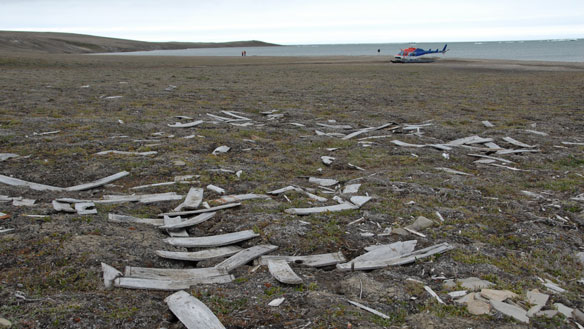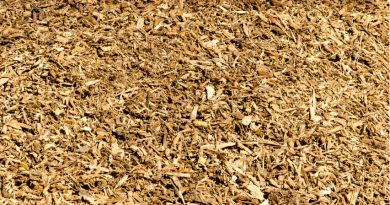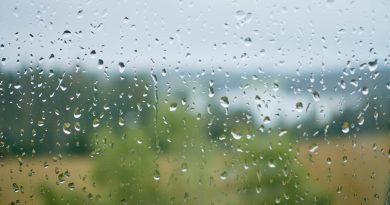HMS Investigator Discovery: A Rewarding Find
 Parks Canada archeologists who found HMS Investigator, a British naval ship that was stranded in the Northwest Passage 155 years ago, are equally pleased to have discovered the graves of three of the ship’s crew.
Parks Canada archeologists who found HMS Investigator, a British naval ship that was stranded in the Northwest Passage 155 years ago, are equally pleased to have discovered the graves of three of the ship’s crew.
The wreck of Investigator was discovered this week at the bottom of Mercy Bay, just off Banks Island in the Northwest Territories. The site of the wreck is in Aulavik National Park.
Parks Canada archeologists located the wreck shortly after they started a sonar scan of Mercy Bay on Sunday, according to officials.
On Monday, another Parks Canada team that was searching on land found the gravesites of three Investigator crew members who died of scurvy in April 1853.
“Just the number of finds within just a short period of time has been really rewarding, from the discovery of the ship to the discovery of the graves,” Henry Cary, a Parks Canada archeologist who took part in the land search, told CBC News on Thursday.
Trapped in ice
The wreck of HMS Investigator, discovered at the bottom of Mercy Bay this week, stands upright in about 11 metres of water, with the upper deck under about eight metres of water. (Parks Canada)Investigator, captained by Robert McClure, was dispatched in 1850 to search for Sir John Franklin’s crew and their two ships, HMS Erebus and HMS Terror, after they disappeared in the Northwest Passage.
The crew were trapped in the ice at Mercy Bay for more than two years, during which time three members — two able seamen and the gunner’s mate — died. The 63 who survived were eventually rescued by a Royal Navy sledge team that took them to another ship.
Before leaving their ship behind, the Investigator crew buried much of the ship’s provisions on Banks Island. Cary’s group was conducting the land search to explore the ship’s cache site, as well as to locate the crew members’ graves.
Cary said historians have known about the deceased men and when they died, but no one really knew where they were buried.
A clue that led the archeologists to the gravesites was found in the recent translation of a diary from a German missionary who had accompanied McClure’s expedition.
An original translation of the diary said the men were buried on the shore, but Cary said his team followed the more recent translation, which suggested the men were buried farther inland.
May be in good condition
Officials estimate that the graves, which are in undisturbed condition, are about 60 metres from the Investigator cache site.
“They’re on the plains just coming up from the beach towards the cache site, and they just look exactly like you’d imagine a freshly dug grave shaft to be, with evidence of the cuts around the sort of oval-shaped boundaries, and then the earth mounded in the centre,” Cary said.
The fact that there are mounds of earth on the graves suggest that the bodies underneath may still be in good condition, Cary added.
“Generally, what happens is as the bodies decompose, the earth begins to collapse in,” he said. “And so instead of getting a mound, you get a divot or a slumping.”
Edward Eastaugh, an anthropology lab manager from the University of Western Ontario, used a magnetometer — a sophisticated metal detector of sorts — that showed the presence of some kind of metal in the graves.
That metal could be from nails or tacks on the men’s coffins, or they could be copper name plates affixed to the coffins, Cary said.
No exhumation plans
Parks Canada has contacted the British government about the discovery of HMS Investigator and the three gravesites, but officials say the sites will remain undisturbed for now.
“Any excavation of these remains would be in the future — certainly not this season, and maybe not next, depending on how we go about deciding whether we are going to excavate them,” Cary said.
“Any future work that we would do on the burials would be approached with extreme respect and caution. We would ensure that there would be a series of consultations and permitting and just going through the whole process to ensure that those remains are treated as respectfully as possible.”
Cary, Eastaugh and the rest of the land crew have until Aug. 3 to finish surveying the site of the graves and the cache for other hidden artifacts.
“The remains themselves are quite extensive, but we’re probably the first to do a real systematic survey of artifacts on the surface,” Cary said.
“Previous groups have not had a huge amount of time, just because of the remoteness of the site, to go over the site over and over again looking for surface finds and different features. So there’s several new discoveries that way.”
Seeking Erebus and Terror
The goal of Robert McClure and those aboard HMS Investigator in 1850 was to find out what happened with Sir John Franklin’s ill-fated expedition to the Northwest Passage.
This week’s discovery comes as Parks Canada resumes a three-year federally funded mission to locate Franklin’s ships, HMS Erebus and HMS Terror. Searchers will head to Queen Maud Gulf in August.
Marc-André Bernier, the head of Parks Canada’s underwater archeology service, said this week’s discovery of HMS Investigator raises their hopes of finally finding Franklin’s long-lost ships.
“It raises the optimism because those are very difficult projects, and to find something like this actually shows that it is feasible,” Bernier told reporters on Wednesday.
“You know, the search for the Erebus and Terror has been going on for 160 years, and a lot of people have taken a shot at it. … We see it as this is huge puzzle for which every single piece counts.”
In 2008, the Parks Canada team found small remnants of copper sheets that may have been part of Erebus and Terror. Search efforts were put on hold in 2009 because a Canadian Coast Guard icebreaker was not available.



